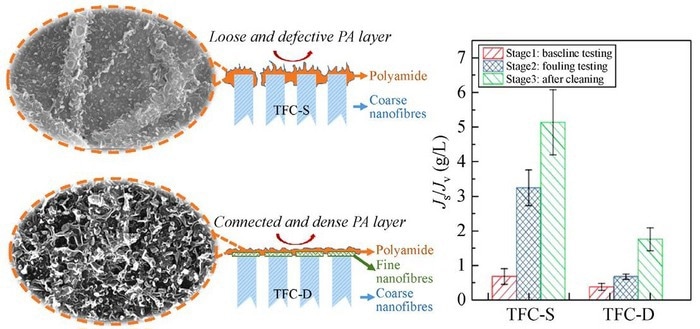Forward osmosis (FO), a new membrane-based technique, has low energy consumption and very little possibility for membrane fouling; however, the shortage of high-performance FO membranes prevents FO from being used widely.

Image Credit: Tao Ma, Haiqing Hui, Xiaofei You, Zhiqiang Pei, Miao Tian, Bing Wu
A high-performance FO membrane should ideally have strong antifouling performance, consistent chemical characteristics, low structural parameter (S value), high water permeability, and low salt permeability. Nanofiber-supported FO membranes have become more popular among them.
Thin-film composite (TFC) FO membranes with exceptional permeability and selectivity are made of porous substrates and ultra-thin polyamide (PA) selective layers. But how can the overall S value of FO membranes be minimized and resolve the “trade-off” between water permeability and solute selectivity?
Due to its robust mechanical qualities and stable chemical properties, Polyvinylidene Fluoride (PVDF), a semi-crystalline polymer with repeating units, is frequently utilized to make membrane materials for water treatment.
However, how can a durable and defect-free PA separation layer be created using interfacial polymerization (IP) on an electro-spun nanofibrous substrate (PVDF) with wide open surface pores? Finally, how to successfully reduce membrane fouling and the internal concentration polarization (ICP) phenomenon in FO has been questioned.
Prof. Miao Tian and Dr. Tao Mao from Northwestern Polytechnical University worked with members of their team to develop a dual-layer PVDF nanofiber-supported TFC FO membrane to address these problems.
Their findings provided a theoretical framework for investigating and developing high-water flux and anti-pollution TFC FO membranes for practical wastewater treatment. They also provided insight into the behavior of foulants on the membrane surface.
The study is published online in Frontiers of Environmental Science & Engineering in 2022.
In this study, a successful electrospinning fabrication of a tier-structured PVDF nanofiber substrate with an ultrathin (~1 µm) fine fiber interlayer on top (average fiber diameter 40–60 nm) was accomplished.
An aforesaid nanofibrous substrate with diverse physicochemical properties was treated with IP to create a PA-selective layer. The performance of the intrinsic separation FO was examined using FESEM and AFM in relation to the electro-spun nanofiber interlayer and drying time.
Model foulants (sodium alginate and bovine serum albumin) in both the feed solution (FS) and draw solution (DS) were used to investigate the separation performance of the dual-layer nanofibrous FO membranes.
When utilizing 1.5 M NaCl against deionized water in the active layer facing draw solution mode, the dual-layer nanofibrous substrate demonstrated a flow of 30.2 LMH, outperforming the single-layer nanofibrous substrate.
If foulants were present in both the FS and DS during the fouling test, the water flux could be efficiently increased without compromising the water/solute selectivity. Furthermore, the cleaning and fouling tests revealed that the dual-layer nanofibrous TFC FO membrane was more durable.
This study shows how essential the interlayer improves the TFC FO membrane. The interlayer improved the PA layer’s selectivity during long-term use and cleaning. To put it briefly, the study offers a theoretical framework for investigating and developing high-water flow and anti-pollution TFC FO membranes for real-world wastewater treatment.
Journal Reference
Ma, T., et al. (2022) Design of nanofibre interlayer supported forward osmosis composite membranes and its evaluation in fouling study with cleaning. Frontiers of Environmental Science & Engineering. doi:10.1007/s11783-022-1550-7